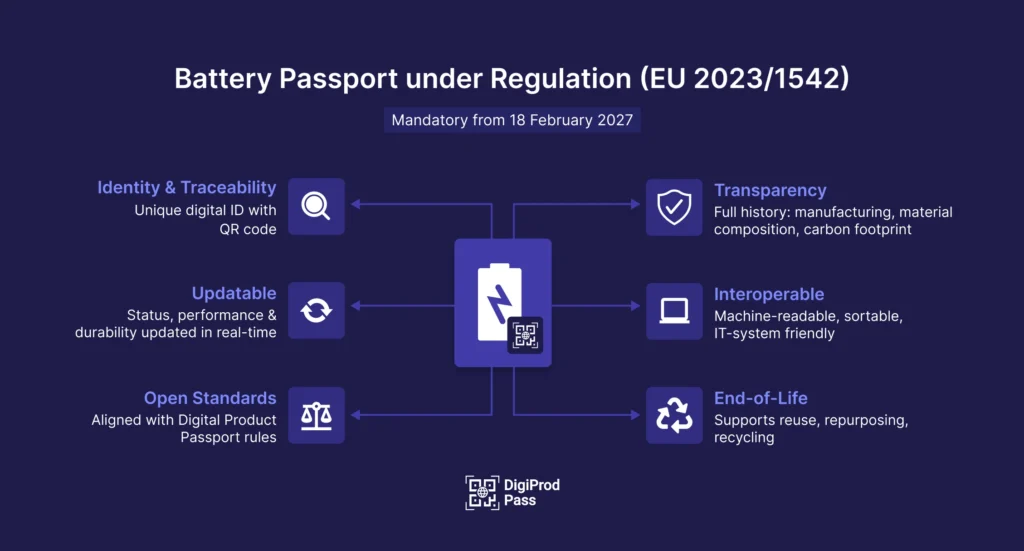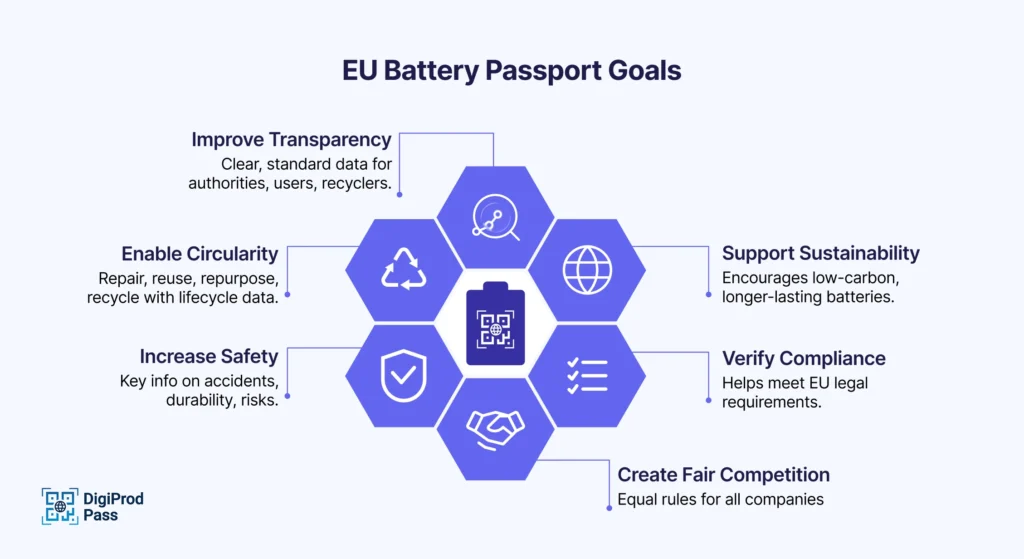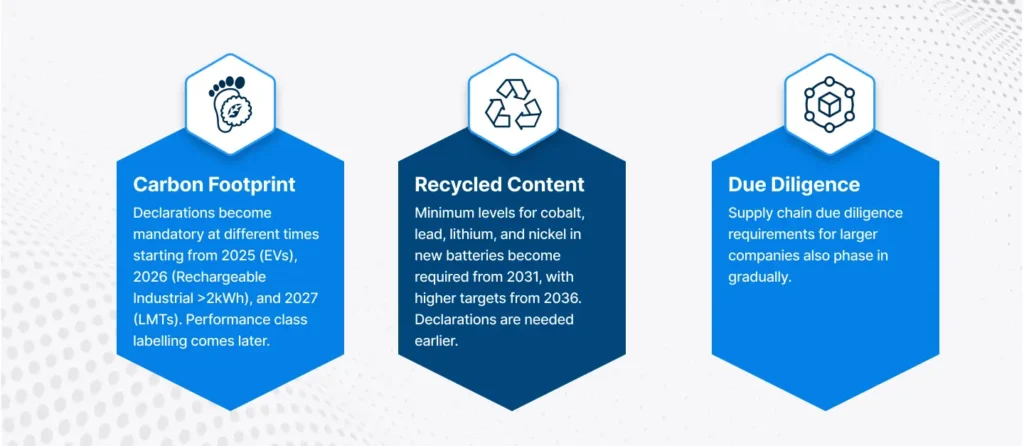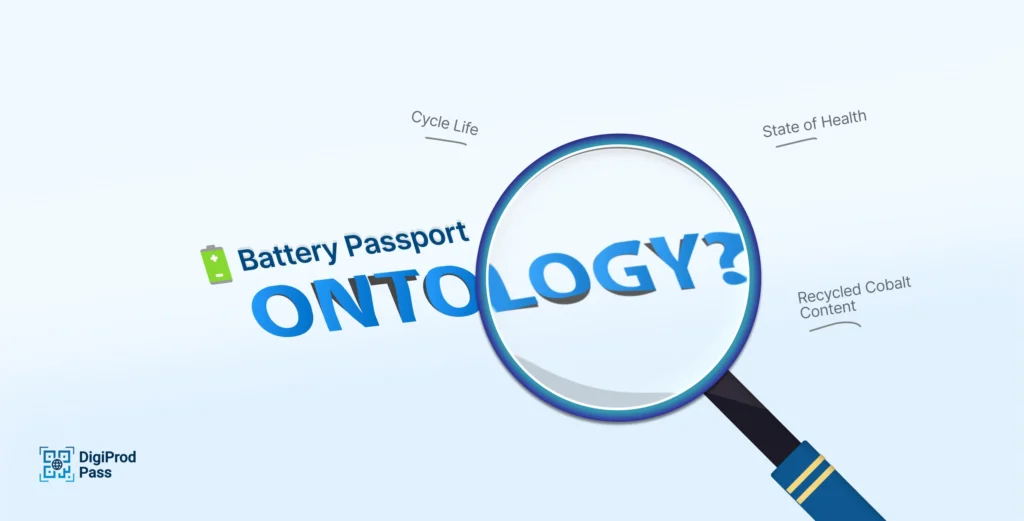EU Digital Battery Passport: The Complete Guide
EU Digital Battery Passport: The Complete Guide
Batteries are the driving force behind countless technologies: – from portable devices like our phones & laptops to large machines like electric cars and home energy systems.
As Europe moves toward cleaner energy and stronger supply chains, it’s recognising batteries as the key to building a green economy.
Recognising battery’s key potential, the European Union (EU) has created new rule: Regulation (EU) 2023/1542 on Batteries and Waste Batteries.
These updated rules don’t just set standards for the battery industry – it guides how batteries are manufactured, tracked, used, and recycled throughout their life.
At the centre of these rules is an important tool: the Digital Product Passport (DPP), as for batteries, the Digital Battery Passport (DBP).
The Battery Passport changes how we handle product information; sharing detailed information about a battery’s materials, performance, origin, and impact on the environment, so everyone involved can make better, safer, and greener choices.
There is a lot of confusion and questions surrounding the Digital Battery Passport in the industry, like
- What is a Digital Battery Passport?
- How does it work?
- How do I become compliant?
-and much more! If you’re someone asking the same questions, don’t worry. This guide will help you understand and get ready for these changes by answering these common yet critical questions:
- What is a Digital Battery Passport, what are its objectives, and what key data must it include?
- Who needs to use Digital Battery Passports, and which type of batteries and businesses are affected?
- When are the implementation deadlines, and what critical dates should manufacturers pay attention to?
We will also touch on some important background concepts that come with the concept, like data management, which are needed to create a working and future-ready Battery Passport System.
So, whether you’re a manufacturer, importer, regulator, or recycler operating in the EU, follow this guide to get all the information you need to know about the new EU Battery Regulation and stay competitive in the field.
What is the Battery Passport under Regulation (EU) 2023/1542?
From 18 February 2027, each LMT battery, each industrial battery with a capacity greater than 2 kWh and each electric vehicle battery placed on the market or put into service shall have an electronic record (‘battery passport’). It’s required by the Battery Regulation EU 2024/1542, and it helps make battery information more transparent, traceable, and recyclable.

By definition, the Digital Battery Passport is an electronic record that provides comprehensive, accurate, and easy-to-access information about a specific battery’s identity, characteristics, manufacturing history, material compositions, carbon footprint, performance, durability, state of health (SOH), supply chain diligence, safety, and requirements for its end-of-life management (reuse, repurposing, and recycling).
The Battery passport is:
- Accessible digitally through a QR code or similar digital identifier attached to the battery
- Updatable, showing the battery’s current status and history
- Made to be machine-readable, sortable and searchable, and work with different IT systems
- Based on open standards, so it will work with future Digital
- Product Passport systems under other EU rules.
Why Do We Need Battery Passports?
The EU created the Battery Passport to meet several important goals related to both the environment and industry.

“The battery passport ensures that all economic operators speak the same language, enabling smart regulation, informed decisions, and stronger enforcement across borders.”
What Information Must Be Included in a Digital Battery Passport?
The Battery Regulation, especially in Annex XIII, lists all the information that must be included in a battery passport. Manufacturers should be responsible to collect, manage, and share the information in six key areas:
- General Battery & Manufacturer Information
- Who made the battery
- Battery type, model, category (e.g. EV, LMT, industrial), and identifying information
- Serial number(s) and batch ID to identify each battery
- When and where it was made
- Weight and chemical composition of the battery
- Material Composition & Sourcing
- Detailed list of materials used, especially CRM or critical raw materials (lithium, natural graphite, cobalt, nickel) and hazardous substances
- How much recycled material is used
- Proof that larger companies get their materials in responsible ways
- Performance and Durability
- Rated battery capacity, voltage, and how long it runs
- Expected lifetime with normal use (in cycles and years)
- How the capacity gets worse over time
- For electric vehicles, e-bikes, and larger industrial batteries (> 2 kWh): ways to check State of Health (SoH) and expected lifetime
- Sustainability & Environmental Impact
- Carbon footprint information (how much carbon was created in making and using it), mandatory for EV, LMT, and rechargeable Industrial > 2kWh units from specific dates. Performance class labelling will follow soon
- Use of clean, renewable energy in the battery production
- Information on repairing and reusing to extend the battery life
- Safety
- Safety and transport standards
- Safe storage and handling instructions
- History of problems (if any)
- End-of-Life Management
- Instructions for safely taking it apart, including tools needed and a step-by-step procedure
- Safety measures for recyclers for the removal and handling of the batteries
- Information for identifying components and materials for easier recycling
The Battery Passport is not just another regulatory requirement – it’s a centralised digital tool that helps create a cleaner, safer, and more recyclable future for batteries in Europe.
As a manufacturer, you need robust data management systems and need to work closely with your suppliers to meet these requirements.
Who needs a Battery Passport by Feb 2027?
By February 18, 2027, all batteries in the following types need a full Battery Passport that can be accessed via QR Code:

It’s better to keep in mind that the data requirements and passport rules may change over time. As of right now, your main focus should be getting ready for having Digital Battery Passports for LMT, industrial >2kWh, and EV battery groups.
Affected Economic Operators
The regulation mentions “Economic Operators” broadly, meaning anyone involved in the supply chain for selling batteries in the EU market:
- Manufacturer: The company designing and making the battery or having it designed/made and selling it under their name/trademark.
- Authorised Representative: A person based in the EU, authorised by a non-EU manufacturer to act for them.
- Importer: A company based in the EU importing a battery from outside the EU into the EU market.
- Distributor: Anyone in the supply chain, other than the manufacturer or importer, who makes a battery available for sale.
- Fulfilment Service Provider: Companies that provide warehousing, packaging, addressing, and shipping services.
As a manufacturer putting your batteries in the EU market, your main responsibility for creating the Battery Passport is making sure it’s accurate and making it accessible to everyone.
Importers have an important role too, as they need to check whether or not the battery manufacturers have followed all the rules before putting the batteries on the market themselves.
That’s not all – sellers need to check if the batteries have the right markings, following the rules properly.
When Does the Battery Passport Requirement Start?
Meeting compliance requirements on time is crucial.. The Battery Regulation has been in effect since February 18th, 2024, with the specific deadline being February 18th, 2027.
From that date, every LMT battery, industrial battery >2kwh, and EV battery sold or being used in the EU must have a proper Battery Passport that can be accessed via a QR code, linked to a unique identifier.
It is important to see this deadline as part of the Regulation’s step-by-step implementation:

While these other deadlines matter, the February 18, 2027, deadline for the operational Battery Passport system for key battery types is the most important milestone for manufacturers regarding Digital Battery Passport implementation.
The QR code linking to the passport must be printed or engraved visibly, clearly, and permanently on the battery itself.
Enabling the System: Understanding Battery Passport Ontology, Interoperability, and Dataspace
Making the Battery Passport system work smoothly across the EU requires data sharing between thousands of manufacturers, recyclers, authorities, and consumers.
To achieve that, we need to understand some key technical concepts:
What is Battery Ontology? (The Common Language)

Imagine what would happen if every battery manufacturer used different terms or units for the same concept. Comparing battery specifications would be a nightmare!
That’s why we need a “common language”, and Battery Ontology aims to solve that problem.
Ontology (in this context) is a formal set of concepts, terms, definitions, properties, and how they relate to each other in the battery world. It creates a standardised vocabulary that computers can understand.
Think of it as a shared dictionary for batteries. It makes sure that when the Battery Passport mentions “State of Health,” “Cycle Life,” or “Recycled Cobalt Content,” everyone – human or machine – knows exactly what that term means and how it’s measured.
A common battery language that EU regulators and industry will likely standardise is key for making data consistent, comparable, and able to be processed automatically.
What is Interoperability? (Systems Talking to Each Other)
Having a common language (ontology) is step one. Step two is making sure that different computer systems can actually exchange and use information based on that language. This is Interoperability.
Interoperability is the ability of different IT systems, apps, and platforms (like a manufacturer’s product system, a recycler’s inventory management, or a regulator’s compliance portal) to communicate, exchange data, and use the shared information effectively.
Interoperability ensures that Battery Passport data created by a manufacturer in their system can be easily accessed, understood, and used by an authorised recycler using their system, without needing complex manual data conversions or custom connections for every single link. It depends heavily on standardised data formats (defined by the ontology) and communication protocols.
What is a Dataspace for the battery ecosystem? (The Secure Exchange Environment)
All this data needs a safe place to be shared. This is where the concept of a Dataspace comes in.
Dataspace is a secure, trusted digital ecosystem that lets different participants (organisations) share and access data based on common rules, standards, and governance frameworks, while keeping control over their own data.
This dataspace isn’t necessarily one big EU database. It’s more likely to be a connected or decentralised system where manufacturers, recyclers, authorities, and others can link their systems and exchange Battery Passport data securely according to clear access rules.
It also ensures that only authorised parties can access specific data points, for example:
- A consumer can access public information
- A recycler can see the detailed composition
- An authority has access to full compliance data
Concepts developed in projects like the automotive-focused Catena-X or the DPP standardisation project CIRPASS give insights into how such battery dataspace connections should work.
The dataspace provides the essential trust, security, and governance layer for the entire system.
As a manufacturer, understanding these concepts will help you grasp the technical foundations that are needed for a fully functional EU-wide Battery Passport System.
How Should Battery Manufacturers Prepare Now?
With the deadline approaching on February 18, 2027, starting your preparation now is not just a good idea – it’s a necessity.
Collecting data, connecting systems, and changing processes can be complex, taking up significant lead time. You can accelerate the process with the most important first steps:
1. Properly Study the Regulation: Don’t just read the summaries! Read the official text from Regulation (EU) 2023/1542.
Understanding the rules properly will help you stay compliant with the requirements, avoiding costly mistakes.
2. Perform a Thorough Data Gap Analysis: Once you have a good understanding of the regulation, compare your existing data against the required Battery Passport data points:
- Which required data do you already have?
- Where is it stored (ERP, PLM, MES, spreadsheets)?
- How accurate and accessible is it?
- What information are you missing?
A thorough data analysis will help you identify the critical gaps in your data
A thorough data analysis will help you identify the critical gaps in your data.
3. Create a Comprehensive Data Strategy: Make a clear plan for how you will:
- Collect the missing data (both from inside your company and from suppliers)
- Make sure the data is accurate and reliable
- Organise your data according to expected data standards and ontology
- Keep data secure throughout its lifecycle
4. Work With Your Supply Chain: Many of your data points (like material origins and component specs) come from your suppliers. You should start communicating with them now:
- Explain your requirements clearly
- Work together to create efficient ways to share data.
5. Evaluate Your IT Infrastructure: Check if your current IT systems can handle the detailed data tracking, security needs, and connections needed for Digital Battery Passport generation.
6. Stay Updated with New Developments: Regularly monitor the European Commission for new Delegated Acts. These will give you more details as time goes on.
Also, follow standardisation efforts (e.g., from CEN/CENELEC) that are related to battery ontology and interoperability protocols.
7. Look into Helpful Technologies: As your plan takes shape, you may want to look into special software or service providers that specialise in Digital Product Passports and regulatory compliance.
They will help you with data management & validation, passport generation, and also ensure ongoing adherence to the regulations.
These platforms can also help you significantly reduce development time and ensure compliance from an early stage.
Conclusion: The Battery Passport – A Compliance Necessity, A Sustainability Enabler
The EU Battery Regulation (EU) 2023/1542 is changing everything for Europe’s battery industry. And Battery Passports are a key part of this change.
It requires new levels of data transparency and depends on some technical elements like ontology, interoperability, and a secure dataspace to work properly.
For battery manufacturers, staying compliant is not optional; it’s necessary to have continued market access in the EU.
While preparation will require significant work in:
- Figuring out your data
- Updating your systems
- Working with your suppliers
- Learning new technical stuff
It’ll also open new opportunities to:
- Demonstrate your commitment to sustainability
- Improve your brand reputation
- Unlock new circular business models
- Help create a more transparent, responsible battery ecosystem in Europe.
The message is clear: don’t wait! Start your assessment, planning, and engagement process today to handle the Battery Regulation requirements confidently and secure your place in the future of the EU battery market.
Related News
Follow us
Batteries are the driving force behind countless technologies: – from portable devices like our phones & laptops to large machines like electric cars and home energy systems.
As Europe moves toward cleaner energy and stronger supply chains, it’s recognising batteries as the key to building a green economy.
Recognising battery’s key potential, the European Union (EU) has created new rule: Regulation (EU) 2023/1542 on Batteries and Waste Batteries.
These updated rules don’t just set standards for the battery industry – it guides how batteries are manufactured, tracked, used, and recycled throughout their life.
At the centre of these rules is an important tool: the Digital Product Passport (DPP), as for batteries, the Digital Battery Passport (DBP).
The Battery Passport changes how we handle product information; sharing detailed information about a battery’s materials, performance, origin, and impact on the environment, so everyone involved can make better, safer, and greener choices.
There is a lot of confusion and questions surrounding the Digital Battery Passport in the industry, like
- What is a Digital Battery Passport?
- How does it work?
- How do I become compliant?
-and much more! If you’re someone asking the same questions, don’t worry. This guide will help you understand and get ready for these changes by answering these common yet critical questions:
- What is a Digital Battery Passport, what are its objectives, and what key data must it include?
- Who needs to use Digital Battery Passports, and which type of batteries and businesses are affected?
- When are the implementation deadlines, and what critical dates should manufacturers pay attention to?
We will also touch on some important background concepts that come with the concept, like data management, which are needed to create a working and future-ready Battery Passport System.
So, whether you’re a manufacturer, importer, regulator, or recycler operating in the EU, follow this guide to get all the information you need to know about the new EU Battery Regulation and stay competitive in the field.
What is the Battery Passport under Regulation (EU) 2023/1542?
From 18 February 2027, each LMT battery, each industrial battery with a capacity greater than 2 kWh and each electric vehicle battery placed on the market or put into service shall have an electronic record (‘battery passport’). It’s required by the Battery Regulation EU 2024/1542, and it helps make battery information more transparent, traceable, and recyclable.

By definition, the Digital Battery Passport is an electronic record that provides comprehensive, accurate, and easy-to-access information about a specific battery’s identity, characteristics, manufacturing history, material compositions, carbon footprint, performance, durability, state of health (SOH), supply chain diligence, safety, and requirements for its end-of-life management (reuse, repurposing, and recycling).
The Battery passport is:
- Accessible digitally through a QR code or similar digital identifier attached to the battery
- Updatable, showing the battery’s current status and history
- Made to be machine-readable, sortable and searchable, and work with different IT systems
- Based on open standards, so it will work with future Digital
- Product Passport systems under other EU rules.
Why Do We Need Battery Passports?
The EU created the Battery Passport to meet several important goals related to both the environment and industry.

“The battery passport ensures that all economic operators speak the same language, enabling smart regulation, informed decisions, and stronger enforcement across borders.”
What Information Must Be Included in a Digital Battery Passport?
The Battery Regulation, especially in Annex XIII, lists all the information that must be included in a battery passport. Manufacturers should be responsible to collect, manage, and share the information in six key areas:
- General Battery & Manufacturer Information
- Who made the battery
- Battery type, model, category (e.g. EV, LMT, industrial), and identifying information
- Serial number(s) and batch ID to identify each battery
- When and where it was made
- Weight and chemical composition of the battery
- Material Composition & Sourcing
- Detailed list of materials used, especially CRM or critical raw materials (lithium, natural graphite, cobalt, nickel) and hazardous substances
- How much recycled material is used
- Proof that larger companies get their materials in responsible ways
- Performance and Durability
- Rated battery capacity, voltage, and how long it runs
- Expected lifetime with normal use (in cycles and years)
- How the capacity gets worse over time
- For electric vehicles, e-bikes, and larger industrial batteries (> 2 kWh): ways to check State of Health (SoH) and expected lifetime
- Sustainability & Environmental Impact
- Carbon footprint information (how much carbon was created in making and using it), mandatory for EV, LMT, and rechargeable Industrial > 2kWh units from specific dates. Performance class labelling will follow soon
- Use of clean, renewable energy in the battery production
- Information on repairing and reusing to extend the battery life
- Safety
- Safety and transport standards
- Safe storage and handling instructions
- History of problems (if any)
- End-of-Life Management
- Instructions for safely taking it apart, including tools needed and a step-by-step procedure
- Safety measures for recyclers for the removal and handling of the batteries
- Information for identifying components and materials for easier recycling
The Battery Passport is not just another regulatory requirement – it’s a centralised digital tool that helps create a cleaner, safer, and more recyclable future for batteries in Europe.
As a manufacturer, you need robust data management systems and need to work closely with your suppliers to meet these requirements.
Who needs a Battery Passport by Feb 2027?
By February 18, 2027, all batteries in the following types need a full Battery Passport that can be accessed via QR Code:

It’s better to keep in mind that the data requirements and passport rules may change over time. As of right now, your main focus should be getting ready for having Digital Battery Passports for LMT, industrial >2kWh, and EV battery groups.
Affected Economic Operators
The regulation mentions “Economic Operators” broadly, meaning anyone involved in the supply chain for selling batteries in the EU market:
- Manufacturer: The company designing and making the battery or having it designed/made and selling it under their name/trademark.
- Authorised Representative: A person based in the EU, authorised by a non-EU manufacturer to act for them.
- Importer: A company based in the EU importing a battery from outside the EU into the EU market.
- Distributor: Anyone in the supply chain, other than the manufacturer or importer, who makes a battery available for sale.
- Fulfilment Service Provider: Companies that provide warehousing, packaging, addressing, and shipping services.
As a manufacturer putting your batteries in the EU market, your main responsibility for creating the Battery Passport is making sure it’s accurate and making it accessible to everyone.
Importers have an important role too, as they need to check whether or not the battery manufacturers have followed all the rules before putting the batteries on the market themselves.
That’s not all – sellers need to check if the batteries have the right markings, following the rules properly.
When Does the Battery Passport Requirement Start?
Meeting compliance requirements on time is crucial.. The Battery Regulation has been in effect since February 18th, 2024, with the specific deadline being February 18th, 2027.
From that date, every LMT battery, industrial battery >2kwh, and EV battery sold or being used in the EU must have a proper Battery Passport that can be accessed via a QR code, linked to a unique identifier.
It is important to see this deadline as part of the Regulation’s step-by-step implementation:

While these other deadlines matter, the February 18, 2027, deadline for the operational Battery Passport system for key battery types is the most important milestone for manufacturers regarding Digital Battery Passport implementation.
The QR code linking to the passport must be printed or engraved visibly, clearly, and permanently on the battery itself.
Enabling the System: Understanding Battery Passport Ontology, Interoperability, and Dataspace
Making the Battery Passport system work smoothly across the EU requires data sharing between thousands of manufacturers, recyclers, authorities, and consumers.
To achieve that, we need to understand some key technical concepts:
What is Battery Ontology? (The Common Language)

Imagine what would happen if every battery manufacturer used different terms or units for the same concept. Comparing battery specifications would be a nightmare!
That’s why we need a “common language”, and Battery Ontology aims to solve that problem.
Ontology (in this context) is a formal set of concepts, terms, definitions, properties, and how they relate to each other in the battery world. It creates a standardised vocabulary that computers can understand.
Think of it as a shared dictionary for batteries. It makes sure that when the Battery Passport mentions “State of Health,” “Cycle Life,” or “Recycled Cobalt Content,” everyone – human or machine – knows exactly what that term means and how it’s measured.
A common battery language that EU regulators and industry will likely standardise is key for making data consistent, comparable, and able to be processed automatically.
What is Interoperability? (Systems Talking to Each Other)
Having a common language (ontology) is step one. Step two is making sure that different computer systems can actually exchange and use information based on that language. This is Interoperability.
Interoperability is the ability of different IT systems, apps, and platforms (like a manufacturer’s product system, a recycler’s inventory management, or a regulator’s compliance portal) to communicate, exchange data, and use the shared information effectively.
Interoperability ensures that Battery Passport data created by a manufacturer in their system can be easily accessed, understood, and used by an authorised recycler using their system, without needing complex manual data conversions or custom connections for every single link. It depends heavily on standardised data formats (defined by the ontology) and communication protocols.
What is a Dataspace for the battery ecosystem? (The Secure Exchange Environment)
All this data needs a safe place to be shared. This is where the concept of a Dataspace comes in.
Dataspace is a secure, trusted digital ecosystem that lets different participants (organisations) share and access data based on common rules, standards, and governance frameworks, while keeping control over their own data.
This dataspace isn’t necessarily one big EU database. It’s more likely to be a connected or decentralised system where manufacturers, recyclers, authorities, and others can link their systems and exchange Battery Passport data securely according to clear access rules.
It also ensures that only authorised parties can access specific data points, for example:
- A consumer can access public information
- A recycler can see the detailed composition
- An authority has access to full compliance data
Concepts developed in projects like the automotive-focused Catena-X or the DPP standardisation project CIRPASS give insights into how such battery dataspace connections should work.
The dataspace provides the essential trust, security, and governance layer for the entire system.
As a manufacturer, understanding these concepts will help you grasp the technical foundations that are needed for a fully functional EU-wide Battery Passport System.
How Should Battery Manufacturers Prepare Now?
With the deadline approaching on February 18, 2027, starting your preparation now is not just a good idea – it’s a necessity.
Collecting data, connecting systems, and changing processes can be complex, taking up significant lead time. You can accelerate the process with the most important first steps:
1. Properly Study the Regulation: Don’t just read the summaries! Read the official text from Regulation (EU) 2023/1542.
Understanding the rules properly will help you stay compliant with the requirements, avoiding costly mistakes.
2. Perform a Thorough Data Gap Analysis: Once you have a good understanding of the regulation, compare your existing data against the required Battery Passport data points:
- Which required data do you already have?
- Where is it stored (ERP, PLM, MES, spreadsheets)?
- How accurate and accessible is it?
- What information are you missing?
A thorough data analysis will help you identify the critical gaps in your data
A thorough data analysis will help you identify the critical gaps in your data.
3. Create a Comprehensive Data Strategy: Make a clear plan for how you will:
- Collect the missing data (both from inside your company and from suppliers)
- Make sure the data is accurate and reliable
- Organise your data according to expected data standards and ontology
- Keep data secure throughout its lifecycle
4. Work With Your Supply Chain: Many of your data points (like material origins and component specs) come from your suppliers. You should start communicating with them now:
- Explain your requirements clearly
- Work together to create efficient ways to share data.
5. Evaluate Your IT Infrastructure: Check if your current IT systems can handle the detailed data tracking, security needs, and connections needed for Digital Battery Passport generation.
6. Stay Updated with New Developments: Regularly monitor the European Commission for new Delegated Acts. These will give you more details as time goes on.
Also, follow standardisation efforts (e.g., from CEN/CENELEC) that are related to battery ontology and interoperability protocols.
7. Look into Helpful Technologies: As your plan takes shape, you may want to look into special software or service providers that specialise in Digital Product Passports and regulatory compliance.
They will help you with data management & validation, passport generation, and also ensure ongoing adherence to the regulations.
These platforms can also help you significantly reduce development time and ensure compliance from an early stage.
Conclusion: The Battery Passport – A Compliance Necessity, A Sustainability Enabler
The EU Battery Regulation (EU) 2023/1542 is changing everything for Europe’s battery industry. And Battery Passports are a key part of this change.
It requires new levels of data transparency and depends on some technical elements like ontology, interoperability, and a secure dataspace to work properly.
For battery manufacturers, staying compliant is not optional; it’s necessary to have continued market access in the EU.
While preparation will require significant work in:
- Figuring out your data
- Updating your systems
- Working with your suppliers
- Learning new technical stuff
It’ll also open new opportunities to:
- Demonstrate your commitment to sustainability
- Improve your brand reputation
- Unlock new circular business models
- Help create a more transparent, responsible battery ecosystem in Europe.
The message is clear: don’t wait! Start your assessment, planning, and engagement process today to handle the Battery Regulation requirements confidently and secure your place in the future of the EU battery market.
Related News
All Catagories
Follow us


